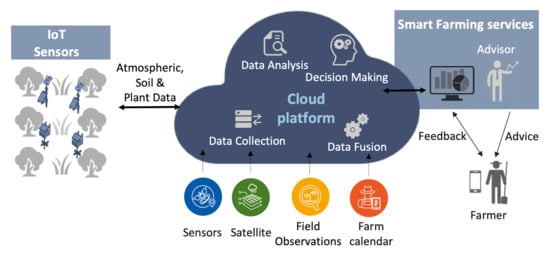Smart Farming Techniques for Climate Change Adaptation in Cyprus
Abstract
1. Introduction
2. Materials and Methods
2.1. Study Area
2.2. Methods of Production and Cropping System
2.3. Smart Farming Approach
2.3.1. From Data Collection to Farming Advice
- Environmental conditions: Solar radiation, precipitation, relative humidity, wind speed, temperature, and soil moisture. Based on these data, it is feasible to calculate the amount of the plant’s moisture loss due to the “evapotranspiration” phenomenon.
- Aquatic state of the plant: Leaf water potential and stomatal conductance that are recorded with the use of sophisticated equipment.
- Other parcel details: Irrigation system, planting distances, crop variety, mechanical soil composition, etc.
- Recordings of irrigation: Time and quantity of irrigation water utilized.
- Amount of irrigation water provided to the parcel;
- Amount of precipitation at the parcel;
- Water loss due to evaporation.
2.3.2. Collected Field Data
2.3.3. Web-Based Application
2.4. Expert Assessment Process
3. Results and Discussion
3.1. Analysis of Collected Data on Irrigation
3.2. Analysis of Collected Data on Pest Management
3.3. Expert Assessment
- Provision of real time on-farm data.
- Accurate information and fast access to information.
- Visual (graphs) and numerical (tables) integration of real time data.
- The user can rely on timely and accurate information.
- The solution facilitates on-farm decision making.
- The solution is relatively user-friendly and provides several critical information that may help reduce costs and manage more effectively the farm. The solution seems to be a smart decision support system.
- Farmers might potentially increase their profits and at the same time protect the environment via the rational use of resources (e.g., irrigation, pesticides).
4. Conclusions
Supplementary Materials
Author Contributions
Funding
Acknowledgments
Conflicts of Interest
References
- EU. Communication from The Commission to The European Parliament, The European Council, The Council, The European Economic and Social Committee and the Committee of The Regions The European Green Deal. Available online: https://ec.europa.eu/info/sites/info/files/european-green-deal-communication_en.pdf (accessed on 2 April 2020).
- FAO. The State of the World’s Land and Water Resources for Food and Agriculture–Managing Systems at Risk; Earthscan, Ed.; Food and Agriculture Organization of the United Nations: London, UK, 2011. [Google Scholar]
- WWAP. Water for a Sustainable World; UNESCO: Paris, France, 2015. [Google Scholar]
- Piesse, M. Global Water Supply and Demand Trends Point Towards Rising Water Insecurity. Available online: http://www.futuredirections.org.au/publication/global-water-supply-and-demand-trends-point-towards-rising-water-insecurity/ (accessed on 26 March 2020).
- Alexandratos, N. World food and agriculture: Outlook for the medium and longer term. Proc. Natl. Acad. Sci. USA 1999, 96, 5908–5914. [Google Scholar] [CrossRef] [PubMed]
- Hatfield, J.L.; Dold, C. Water-Use Efficiency: Advances and Challenges in a Changing Climate. Front. Plant Sci. 2019, 10. [Google Scholar] [CrossRef] [PubMed]
- Malheiro, M.T.; Pereira, R.M.S.; Gonçalves, A.M.; Pereira, P.A.S.; Caldeira, A.C.; Lopes, S.O. Hands on Experiments about Water Needs in Agriculture and Their Mathematical Modelling under Climate Change. In Proceedings of the 2019 3rd International Conference on E-Society, E-Education and E-Technology, Taipei, Taiwan, 15–17 August 2019; pp. 131–135. [Google Scholar]
- Bashir, R.N.; Bajwa, I.S.; Shahid, M.M.A. Internet of Things (IoT) and Machine Learning based Leaching Requirements Estimation for Saline Soils. IEEE Internet Things J. 2019. [Google Scholar] [CrossRef]
- Zecca, F. The Use of Internet of Things for the Sustainability of the Agricultural Sector: The Case of Climate Smart Agriculture. Int. J. Civ. Eng. Technol. 2019, 10, 494–501. [Google Scholar]
- Walter, A.; Finger, R.; Huber, R.; Buchmann, N. Opinion: Smart farming is key to developing sustainable agriculture. Proc. Natl. Acad. Sci. USA 2017, 114, 6148–6150. [Google Scholar] [CrossRef]
- Brewster, C.; Roussaki, I.; Kalatzis, N.; Doolin, K.; Ellis, K. IoT in agriculture: Designing a Europe-wide large-scale pilot. IEEE Commun. Mag. 2017, 55, 26–33. [Google Scholar] [CrossRef]
- Chen, W.; Lin, Y.; Lin, Y.; Chen, R.; Liao, J.; Ng, F.; Chan, Y.; Liu, Y.; Wang, C.; Chiu, C.; et al. AgriTalk: IoT for Precision Soil Farming of Turmeric Cultivation. IEEE Internet Things J. 2019, 6, 5209–5223. [Google Scholar] [CrossRef]
- Dorsemaine, B.; Gaulier, J.-P.; Wary, J.-P.; Kheir, N.; Urien, P. Internet of things: A definition & taxonomy. In Proceedings of the 2015 9th International Conference on Next Generation Mobile Applications, Services and Technologies, Cambridge, UK, 9–11 September 2015; pp. 72–77. [Google Scholar]
- Elijah, O.; Rahman, T.A.; Orikumhi, I.; Leow, C.Y.; Hindia, M.N. An overview of Internet of Things (IoT) and data analytics in agriculture: Benefits and challenges. IEEE Internet Things J. 2018, 5, 3758–3773. [Google Scholar] [CrossRef]
- Villa-Henriksen, A.; Edwards, G.T.C.; Pesonen, L.A.; Green, O.; Sørensen, C.A.G. Internet of Things in arable farming: Implementation, applications, challenges and potential. Biosyst. Eng. 2020, 191, 60–84. [Google Scholar] [CrossRef]
- Tzounis, A.; Katsoulas, N.; Bartzanas, T.; Kittas, C. Internet of Things in agriculture, recent advances and future challenges. Biosyst. Eng. 2017, 164, 31–48. [Google Scholar] [CrossRef]
- Botta, A.; De Donato, W.; Persico, V.; Pescapé, A. Integration of cloud computing and internet of things: A survey. Future Gener. Comput. Syst. 2016, 56, 684–700. [Google Scholar] [CrossRef]
- Rose, D.; Chilvers, J. Agriculture 4.0: Responsible innovation in an era of smart farming. Front. Sustain. Food Syst. 2018, 2, 87. [Google Scholar] [CrossRef]
- Ramundo, L.; Taisch, M.; Terzi, S. State of the art of technology in the food sector value chain towards the IoT. In Proceedings of the 2016 IEEE 2nd International Forum on Research and Technologies for Society and Industry Leveraging a better tomorrow (RTSI), Bologna, Italy, 7–9 September 2016; pp. 1–6. [Google Scholar]
- García, L.; Parra, L.; Jimenez, J.M.; Lloret, J.; Lorenz, P. IoT-Based Smart Irrigation Systems: An Overview on the Recent Trends on Sensors and IoT Systems for Irrigation in Precision Agriculture. Sensors 2020, 20, 1042. [Google Scholar] [CrossRef] [PubMed]
- European Commission. Factsheet on 2014–2020 Rural Development Programme for Cyprus; European Commission: Brussels, Belgium, 2019; p. 7. [Google Scholar]
- Adamides, G.; Stylianou, A.; Kosmas, P.C.; Apostolopoulos, C.D. Factors affecting PC and Internet usage by the rural population of Cyprus. Agric. Econ. Rev. 2013, 14, 16–36. [Google Scholar]
- Ferrández-Pastor, F.; García-Chamizo, J.; Nieto-Hidalgo, M.; Mora-Pascual, J.; Mora-Martínez, J. Developing ubiquitous sensor network platform using internet of things: Application in precision agriculture. Sensors 2016, 16, 1141. [Google Scholar] [CrossRef] [PubMed]
- Ojha, T.; Misra, S.; Raghuwanshi, N.S. Wireless sensor networks for agriculture: The state-of-the-art in practice and future challenges. Comput. Electron. Agric. 2015, 118, 66–84. [Google Scholar] [CrossRef]
- Gangwar, D.S.; Tyagi, S.; Soni, S.K. A conceptual framework of agroecological resource management system for climate-smart agriculture. Int. J. Environ. Sci. Technol. 2019, 16, 4123–4132. [Google Scholar] [CrossRef]
- CYStat. Agricultural Statistics 2015; Cyprus Statistical Service: Nicosia, Cyprus, 2017; p. 111. [Google Scholar]
- Markou, M.; Stylianou, A.; Giannakopoulou, M.; Adamides, G. Identifying Business-to-Business Unfair Trading Practices in the Food Supply Chain: The case of Cyprus. New Medit 2020, 19, 19–34. [Google Scholar] [CrossRef]
- Stylianou, A.; Sdrali, D.; Apostolopoulos, C.D. Capturing the diversity of Mediterranean farming systems prior to their sustainability assessment: The case of Cyprus. Land Use Policy 2020, 96. [Google Scholar] [CrossRef]
- Sofroniou, A.; Bishop, S. Water scarcity in Cyprus: A review and call for integrated policy. Water 2014, 6, 2898–2928. [Google Scholar] [CrossRef]
- Hadjidemetriou, T. Lack of Water Resources and Agriculture; Council of Europe Publishing: The Hague, The Netherlands, 2000. [Google Scholar]
- Nikolaou, G.; Neocleous, D.; Christophi, C.; Heracleous, T.; Markou, M. Irrigation Groundwater Quality Characteristics: A Case Study of Cyprus. Atmosphere 2020, 11, 302. [Google Scholar] [CrossRef]
- Constantinidou, K.; Zittis, G.; Hadjinicolaou, P. Variations in the simulation of climate change impact indices due to different land surface schemes over the Mediterranean, Middle East and northern Africa. Atmosphere 2019, 10, 26. [Google Scholar] [CrossRef]
- Lange, M.A. Impacts of climate change on the eastern Mediterranean and the Middle East and North Africa region and the water–energy nexus. Atmosphere 2019, 10, 455. [Google Scholar] [CrossRef]
- Papadavid, G.; Neocleous, D.; Kountios, G.; Markou, M.; Michailidis, A.; Ragkos, A.; Hadjimitsis, D. Using SEBAL to Investigate How Variations in Climate Impact on Crop Evapotranspiration. J. Imaging 2017, 3, 30. [Google Scholar] [CrossRef]
- Verdouw, C.; Wolfert, J.; Beers, G.; Sundmaeker, H.; Chatzikostas, G. Fostering business and software ecosystems for large-scale uptake of IoT in food and farming. In Proceedings of the PA17-The International Tri-Conference for Precision Agriculture in 2017, Hamilton, New Zealand, 16–18 October 2017. [Google Scholar]
- Kalatzis, N.; Marianos, N.; Chatzipapadopoulos, F. IoT and data interoperability in agriculture: A case study on the gaiasense TM smart farming solution. In Proceedings of the 2019 Global IoT Summit (GIoTS), Aarhus, Denmark, 17–21 June 2019; pp. 1–6. [Google Scholar]
- Marianos, N.; Kalatzis, N.; Sykas, D. Earth observation for smart farming and cap performance. In The Ever-Growing Use of Copernicus Across Europe’s Regions; NEREUS, Ed.; European Commission: Brussels, Belgium, 2018. [Google Scholar]
- Damos, P.; Savopoulou-Soultani, M. Temperature-driven models for insect development and vital thermal requirements. Psyche J. Entomol. 2012, 13. [Google Scholar] [CrossRef]
- Leiminger, J.; Hausladen, H. Early blight control in potato using disease-orientated threshold values. Plant Dis. 2012, 96, 124–130. [Google Scholar] [CrossRef]
- Escuredo, O.; Seijo-Rodríguez, A.; Rodríguez-Flores, M.S.; Seijo, M.C. Decision Support Systems for Detecting Aerial Potato Phytophthora infestans Sporangia in Northwestern Spain. Agron. J. 2019, 111, 354–361. [Google Scholar] [CrossRef]
- Kantwa, S.; Shekhawat, K.; Tetarwal, J. Studies on physiological parameters of Alternaria alternata (Fr) keissler-The incitant of leaf blight of groundnut. Int. J. Plant Prot. 2015, 8, 359–363. [Google Scholar] [CrossRef]
- Maheshwari, S.; Singh, D.; Singh, S. Effect of temperature and pH on growth and sporulation of Alternaria alternata causing Alternaria leaf spot of dolichos bean. Ann. Plant Prot. Sci. 2000, 8, 33–35. [Google Scholar]
- Patakas, A. Abiotic stress-induced morphological and anatomical changes in plants. In Abiotic Stress Responses in Plants; Springer: Berlin/Heidelberg, Germany, 2012; pp. 21–39. [Google Scholar]
- Karafyllidis, D.; Stavropoulos, N.; Georgakis, D. The effect of water stress on the yielding capacity of potato crops and subsequent performance of seed tubers. Potato Res. 1996, 39, 153–163. [Google Scholar] [CrossRef]
- Allen, R.G.; Pereira, L.S.; Raes, D.; Smith, M. Crop evapotranspiration-Guidelines for computing crop water requirements-FAO Irrigation and drainage paper 56. Fao Rome 1998, 300, D05109. [Google Scholar]
- Christou, A.; Dalias, P.; Neocleous, D. Spatial and temporal variations in evapotranspiration and net water requirements of typical Mediterranean crops on the island of Cyprus. J. Agric. Sci. 2017, 155, 1311–1323. [Google Scholar] [CrossRef]
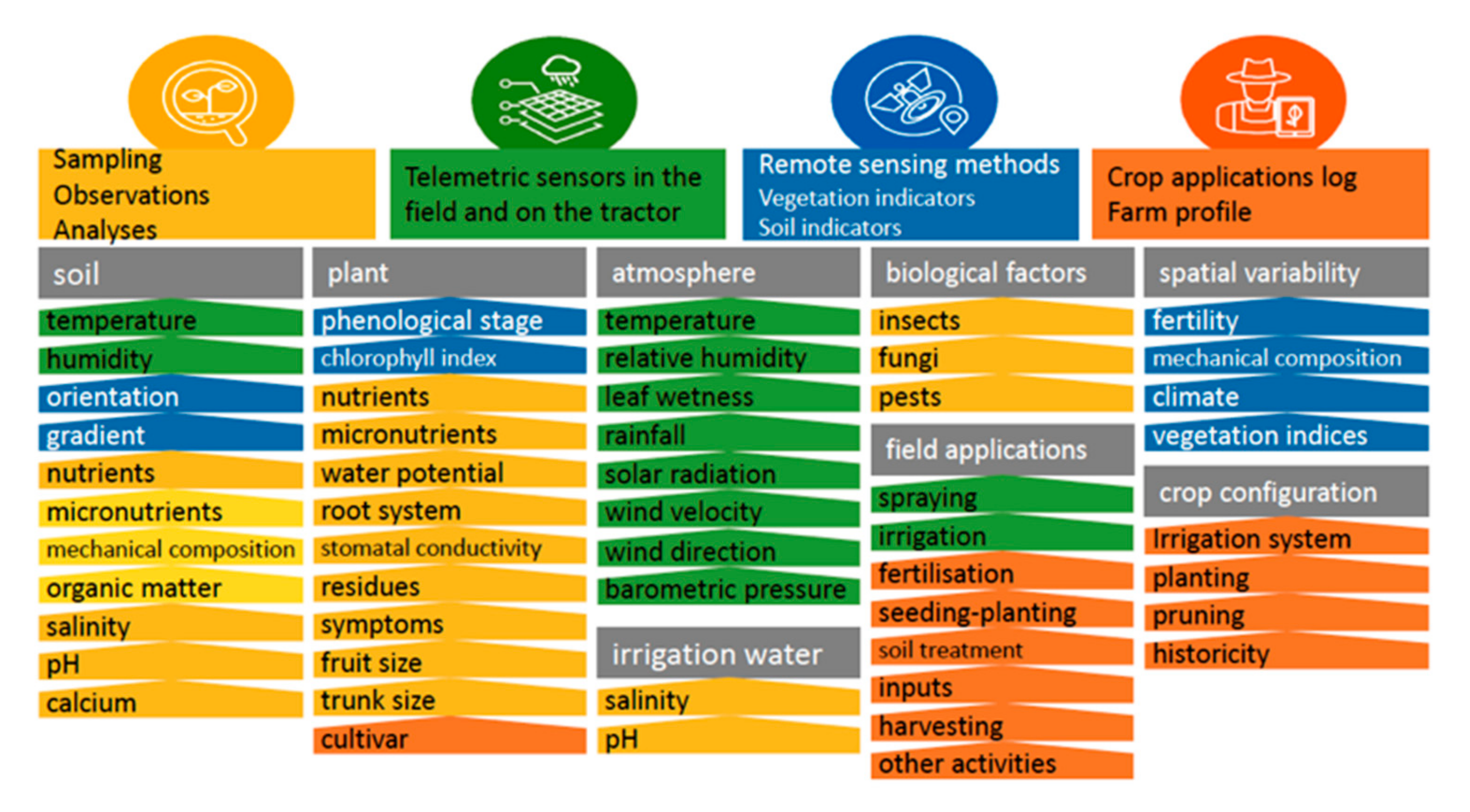
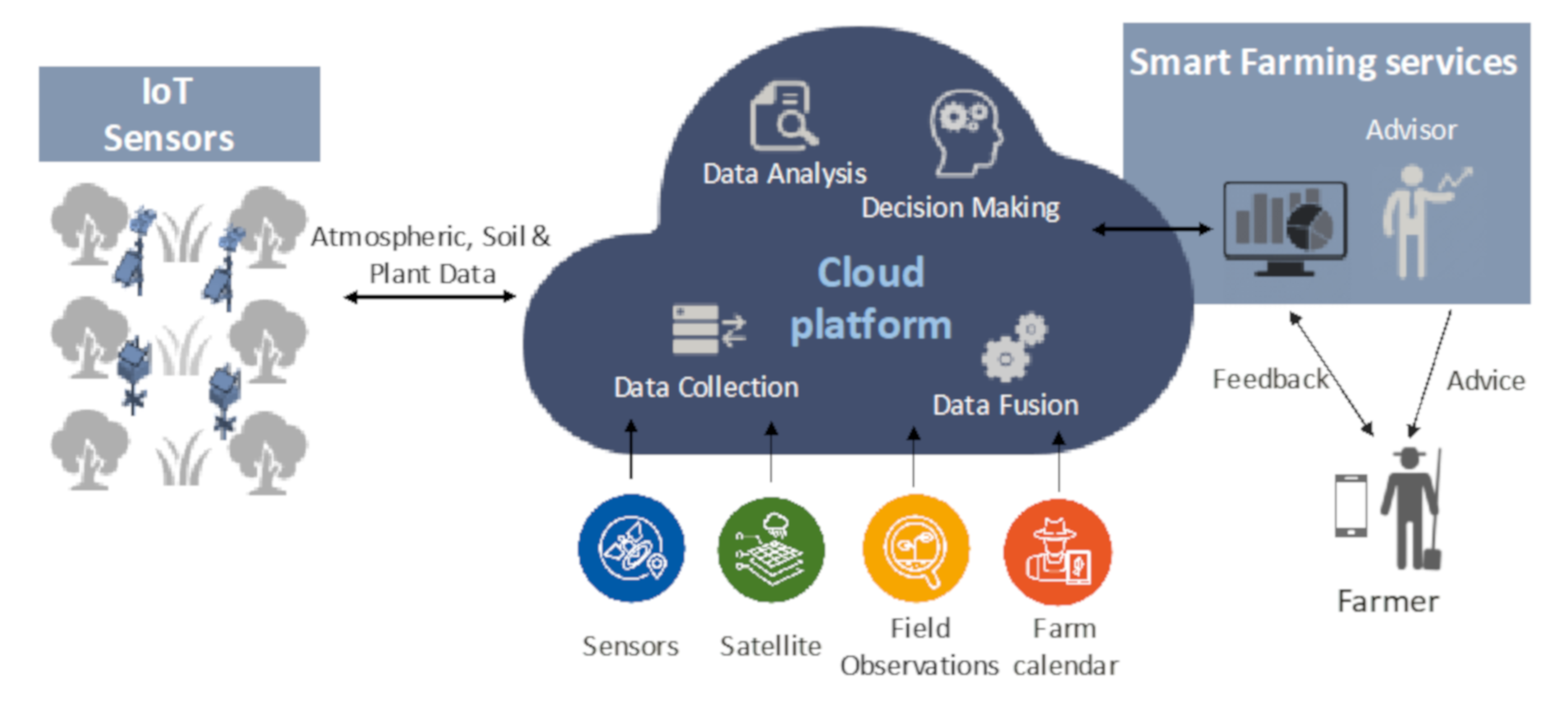
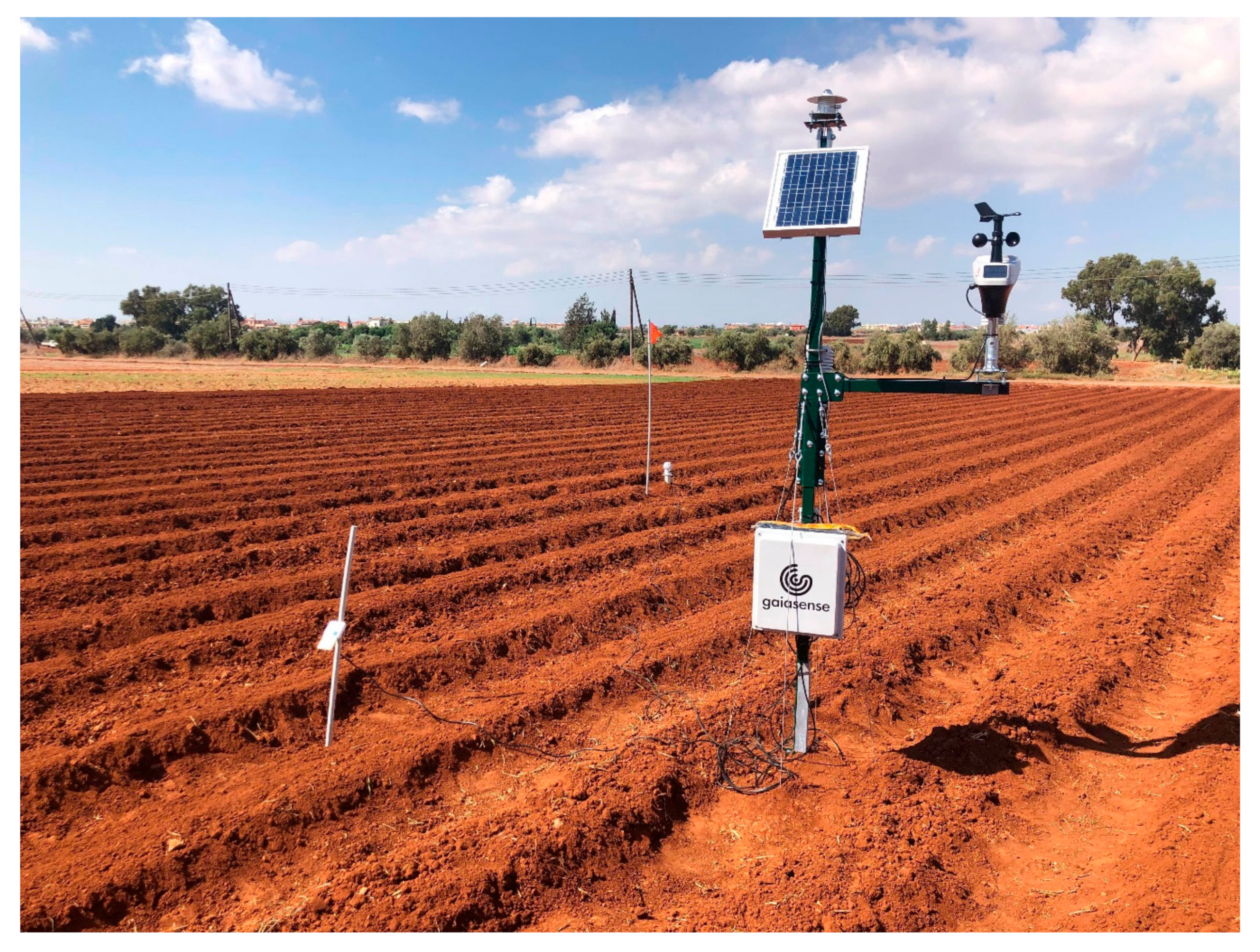
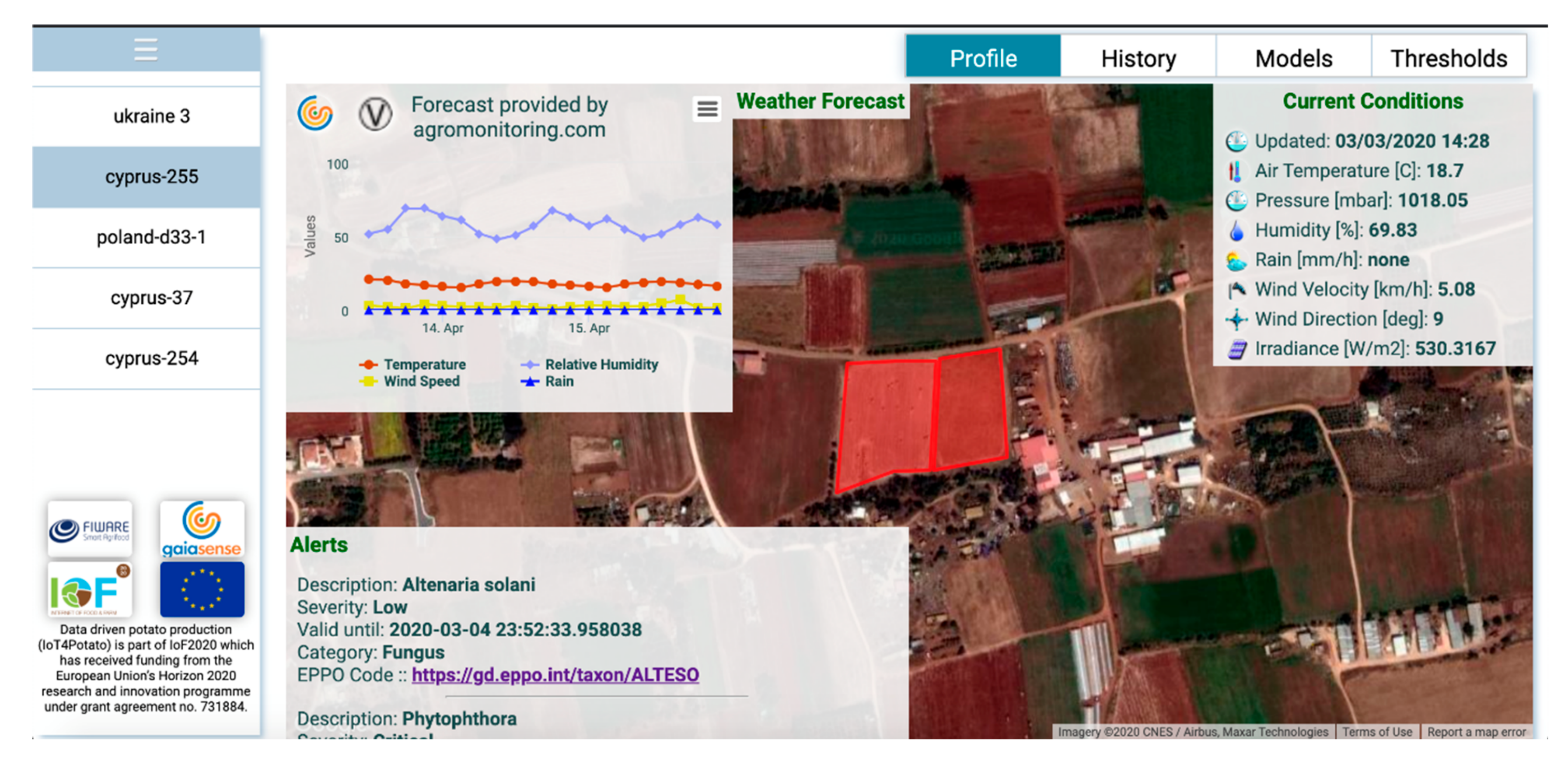
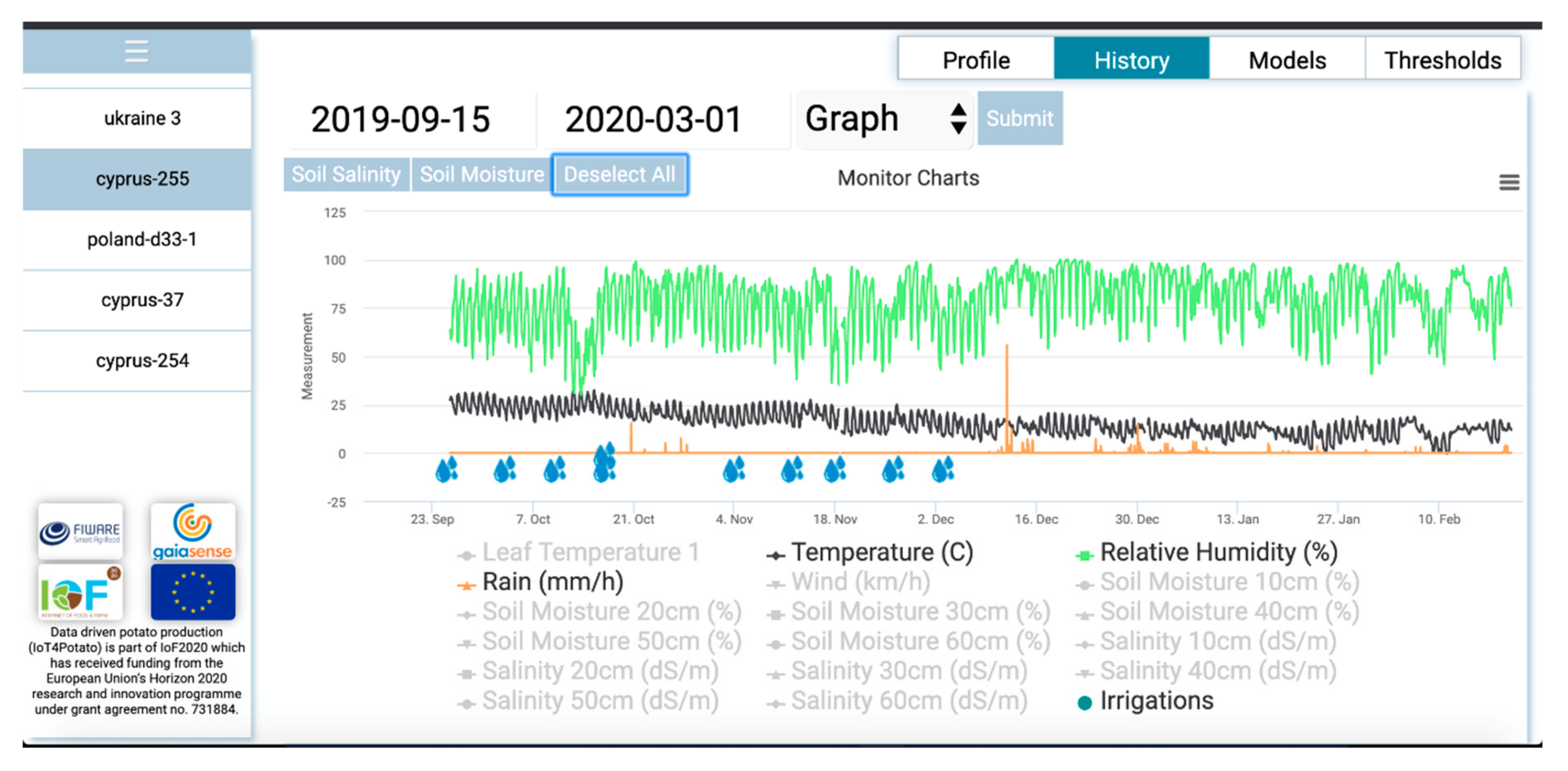
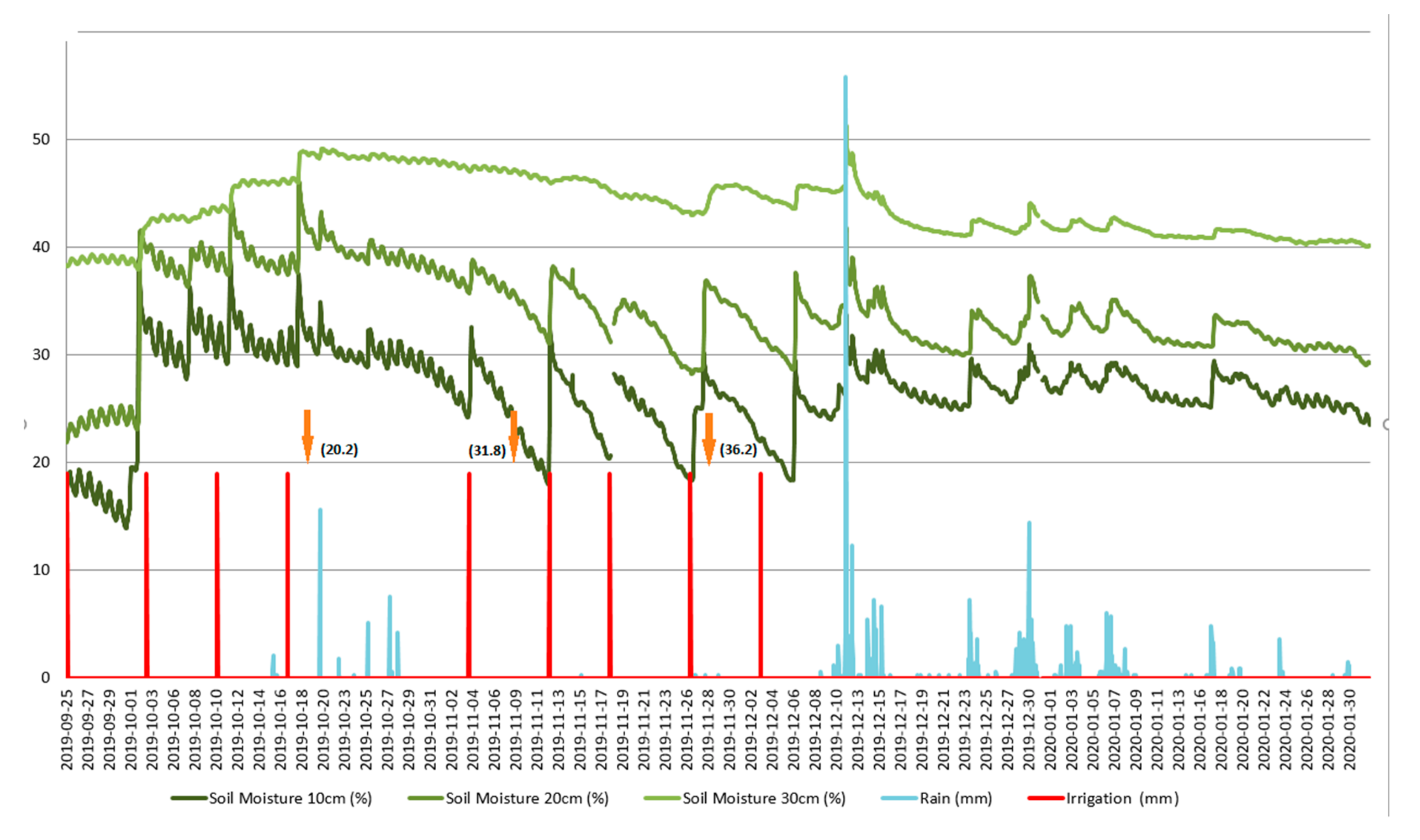
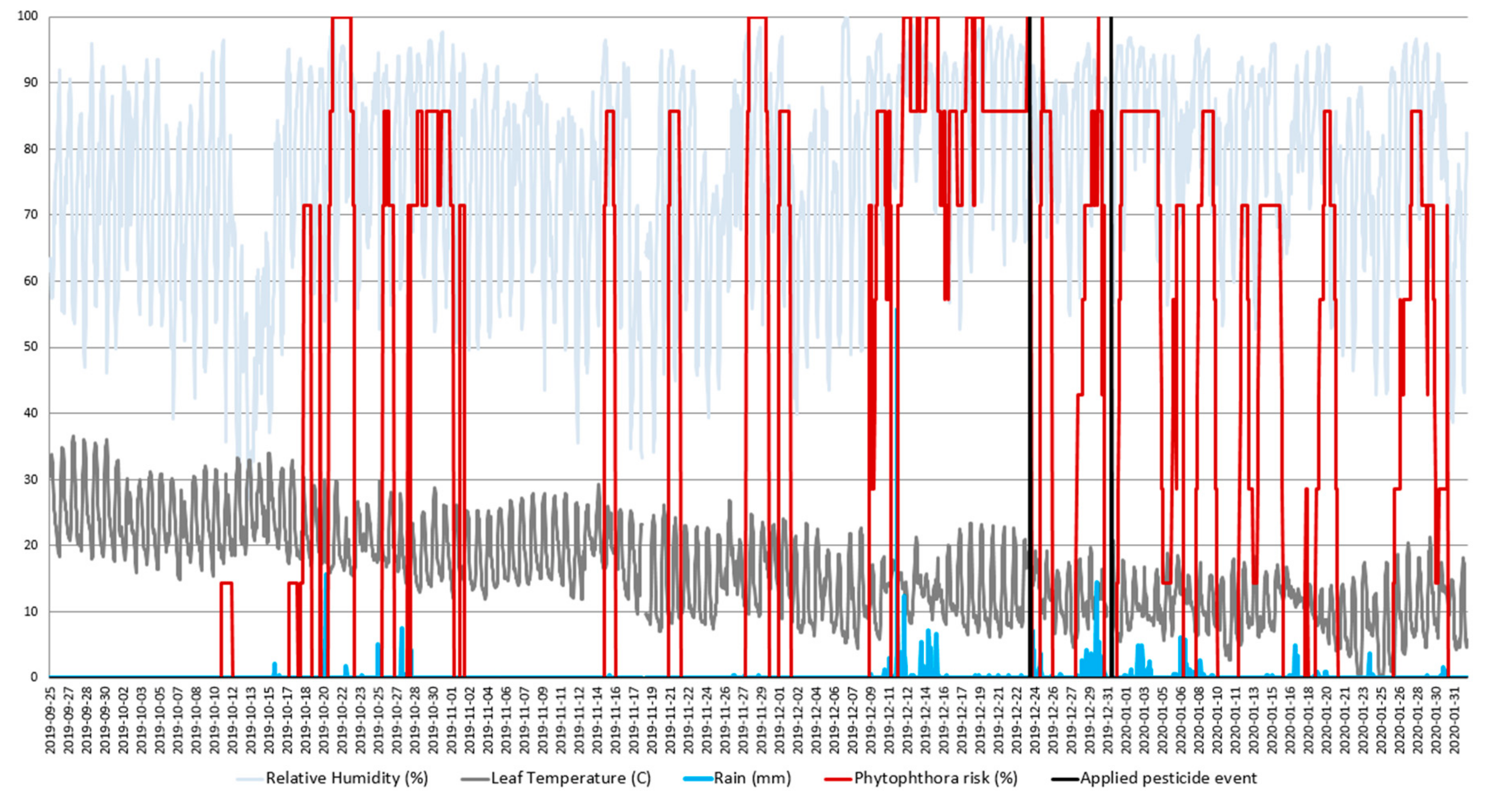
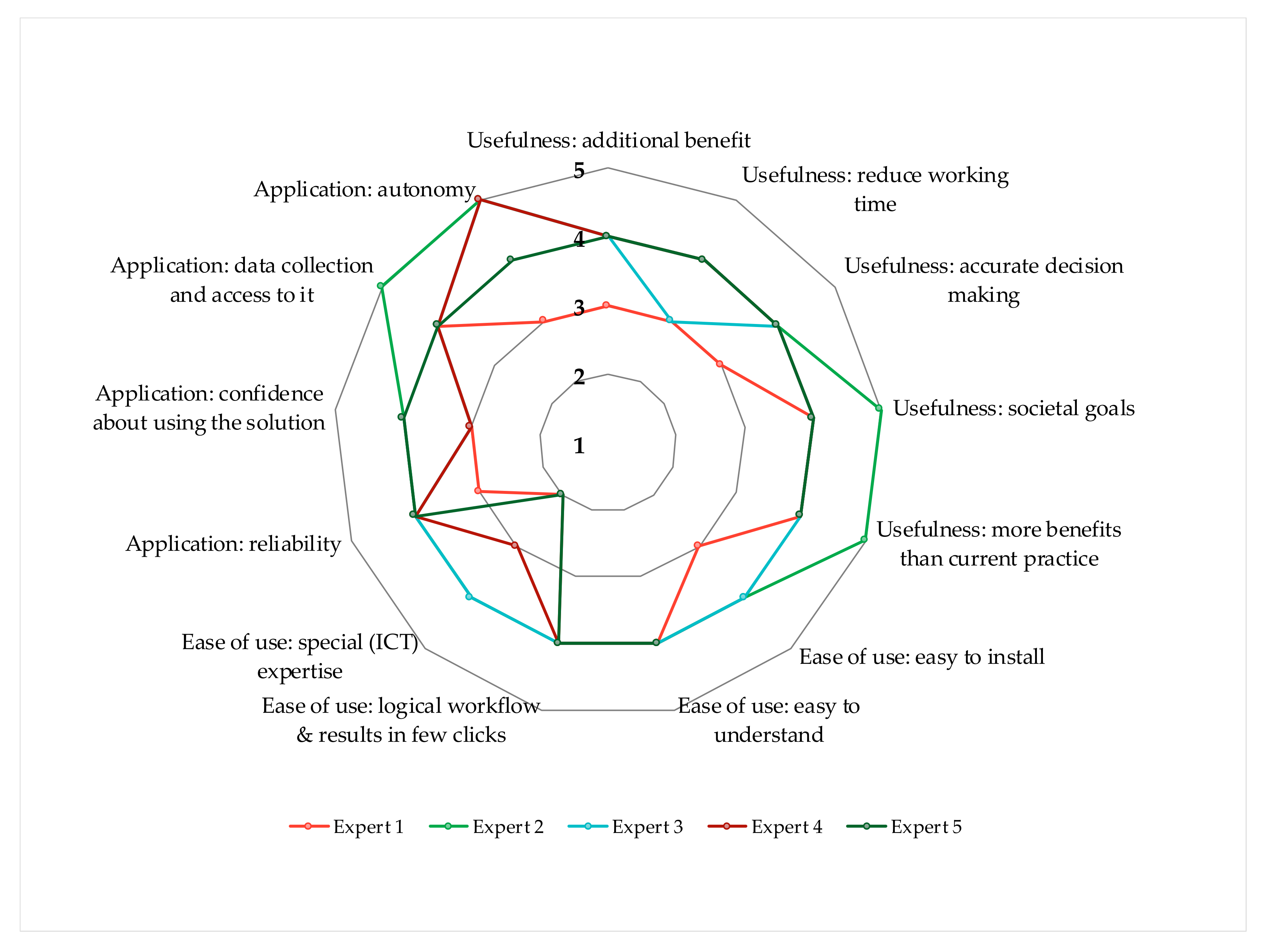
© 2020 by the authors. Licensee MDPI, Basel, Switzerland. This article is an open access article distributed under the terms and conditions of the Creative Commons Attribution (CC BY) license (http://creativecommons.org/licenses/by/4.0/).
Share and Cite
Adamides, G.; Kalatzis, N.; Stylianou, A.; Marianos, N.; Chatzipapadopoulos, F.; Giannakopoulou, M.; Papadavid, G.; Vassiliou, V.; Neocleous, D. Smart Farming Techniques for Climate Change Adaptation in Cyprus. Atmosphere 2020, 11, 557. https://doi.org/10.3390/atmos11060557
Adamides G, Kalatzis N, Stylianou A, Marianos N, Chatzipapadopoulos F, Giannakopoulou M, Papadavid G, Vassiliou V, Neocleous D. Smart Farming Techniques for Climate Change Adaptation in Cyprus. Atmosphere. 2020; 11(6):557. https://doi.org/10.3390/atmos11060557
Chicago/Turabian StyleAdamides, George, Nikos Kalatzis, Andreas Stylianou, Nikolaos Marianos, Fotis Chatzipapadopoulos, Marianthi Giannakopoulou, George Papadavid, Vassilis Vassiliou, and Damianos Neocleous. 2020. "Smart Farming Techniques for Climate Change Adaptation in Cyprus" Atmosphere 11, no. 6: 557. https://doi.org/10.3390/atmos11060557
APA StyleAdamides, G., Kalatzis, N., Stylianou, A., Marianos, N., Chatzipapadopoulos, F., Giannakopoulou, M., Papadavid, G., Vassiliou, V., & Neocleous, D. (2020). Smart Farming Techniques for Climate Change Adaptation in Cyprus. Atmosphere, 11(6), 557. https://doi.org/10.3390/atmos11060557









